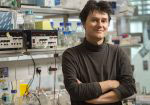

A critical event in the origin of life is thought to have been the emergence of an RNA molecule capable of self-replication as well as mutation, and hence evolution towards ever more efficient replication.
The Holliger lab uses synthetic biology approaches to reconstruct modern day equivalents of the ancestral replicase and study life’s first genetic system “by proxy” with the use of modern-day RNA enzymes (ribozymes) generated by in vitro evolution. Progress in this area has fundamental implications for a better understanding of both the origin of life and the engineering of simple chemical systems with life-like properties.
Previously we have discovered RNA polymerase ribozymes that are capable of the templated synthesis of another simple ribozyme (Wochner et al, 2011) or long (> 200 nt) RNA oligomers and this activity is potentiated by structured media such as the eutectic phase of water ice (Attwater et al, 2013).
More recently, we have discovered polymerase ribozymes that utilize trinucleotide triphosphates (triplets) as substrates (Attwater et al, 2018). Such triplet polymerase ribozymes (TPR) show a remarkable ability to replicate highly structured RNAs as well as enabling non-canonical primer-free and reverse direction (3’-5’) modes of RNA replication not seen in nature, and - in the case of a recently discovered small TPR - the templated synthesis of its own (+) and (-) strands, an important step towards self-replication (Gianni et al, 2024).
Using coupled pH and freeze-thaw cycles, we show that the TPR can replicate and exponentially amplify double-stranded RNAs including parts of itself using triplet substrates (Attwater et al, 2025). Recently we have also solved the structure of a TPR apoenzyme by cryo-electron microscopy (CryoEM) (McRae et al, 2024) providing the foundation for a better understanding of the potential of RNA for self-replication.
Potential projects will focus on advancing RNA-catalyzed RNA synthesis using in vitro evolution, machine learning and structural analysis (CryoEM) towards the engineering of an RNA system capable of self-replication and evolution.
References
Ribozyme-catalyzed transcription of an active ribozyme.
Science 332(6026): 209-12 (2011)
In-ice evolution of RNA polymerase ribozyme activity.
Nat Chem 5(12): 1011-8 (2013)
Ribozyme-catalysed RNA synthesis using triplet building blocks.
Elife 7: (2018) Epub
A polymerase ribozyme that can synthesize both itself and its complementary strand
bioRxiv: (2024) preprint
Cryo-EM structure and functional landscape of an RNA polymerase ribozyme
Proceedings of the National Academy of Sciences 121(3): (2024)
Trinucleotide substrates under pH-freeze-thaw cycles enable open-ended exponential RNA replication by a polymerase ribozyme.
Nat Chem 17(7): 1129-1137 (2025)